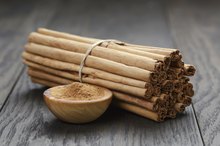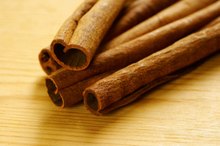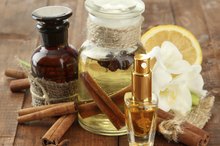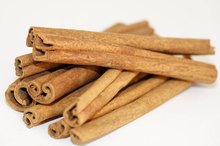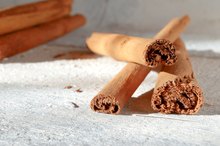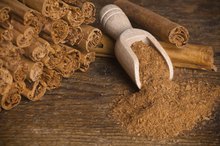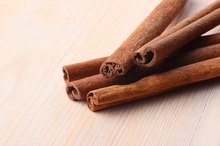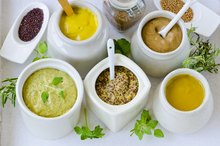What does fact checked mean?
At Healthfully, we strive to deliver objective content that is accurate and up-to-date. Our team periodically reviews articles in order to ensure content quality. The sources cited below consist of evidence from peer-reviewed journals, prominent medical organizations, academic associations, and government data.
The information contained on this site is for informational purposes only, and should not be used as a substitute for the advice of a professional health care provider. Please check with the appropriate physician regarding health questions and concerns. Although we strive to deliver accurate and up-to-date information, no guarantee to that effect is made.
Cinnamon Allergy Symptoms
Individuals who experience unusual reactions after touching or eating cinnamon may have a cinnamon allergy. Although learning about the most common symptoms of a cinnamon allergy is the first step in determining if an allergy is present, the specific symptoms of an allergy can vary greatly from person to person. Those who suspect a cinnamon allergy should always see a doctor or allergist for a proper diagnosis and to explore treatment options.
If you are experiencing serious medical symptoms, seek emergency treatment immediately.
Contact Dermatitis
Contact dermatitis is a skin reaction that occurs when a person is exposed to an allergen. This skin reaction may cause inflammation, redness or a rash on the areas of the skin that came in contact with cinnamon.
Gastrointestinal Upset
How Many Calories Does Cinnamon Have?
Learn More
Individuals who ingest cinnamon may suffer from gastrointestinal upset. This may include diarrhea, nausea, vomiting or stomach cramps. Although this gastrointestinal upset may occur within minutes of eating cinnamon, it also can occur up to two hours later, explains the American Academy of Allergy, Asthma and Immunology.
Cold-like Symptoms
Some people may experience symptoms similar to that of the common cold after being exposed to cinnamon, such as a runny or stuffy nose, watery or itching eyes or coughing. In some cases, a person may also have wheezing or difficulty breathing. If these symptoms are due to a cinnamon allergy, the gastrointestinal symptoms and skin reactions will typically also be present, notes the American Academy of Allergy, Asthma and Immunology.
- Some people may experience symptoms similar to that of the common cold after being exposed to cinnamon, such as a runny or stuffy nose, watery or itching eyes or coughing.
- If these symptoms are due to a cinnamon allergy, the gastrointestinal symptoms and skin reactions will typically also be present, notes the American Academy of Allergy, Asthma and Immunology.
Anaphylactic Shock
Here’s How Cinnamon Can be Used for A Duodenal Ulcer
Learn More
Although less common than the other symptoms, some individuals who are allergic to cinnamon develop a condition called anaphylactic shock. This is a severe and potentially life-threatening condition. The symptoms of anaphylactic shock include abdominal pain, unusual heartbeat, dizziness or lightheadedness, confusion, a sudden drop in blood pressure, shock, or a loss of consciousness, says MedlinePlus 2. Those who show signs of anaphylactic shock need immediate medical attention.
- Although less common than the other symptoms, some individuals who are allergic to cinnamon develop a condition called anaphylactic shock.
Related Articles
References
- Food and Drug Administration: Food Allergies--What You Need to Know
- MedlinePlus: Anaphylaxis
- Rao PV, Gan SH. Cinnamon: A Multifaceted Medicinal Plant. Evid Based Complement Alternat Med. 2014;2014:642942. doi:10.1155/2014/642942
- Khan A, Safdar M, Ali Khan MM, Khattak KN, Anderson RA. Cinnamon Improves Glucose and Lipids of People With Type 2 Diabetes. Diabetes Care. 2003;26(12):3215-3218. doi:10.2337/diacare.26.12.3215
- Mollazadeh H, Hosseinzadeh H. Cinnamon effects on metabolic syndrome: a review based on its mechanisms. Iran J Basic Med Sci. 2016;19(12):1258-1270. doi:10.22038/IJBMS.2016.7906
- Gruenwald J, Freder J, Armbruester N. Cinnamon and Health. Crit Rev Food Sci Nutr. 2010;50(9):822-834. doi:10.1080/10408390902773052
- Goel N, Rohilla H, Singh G, Punia P. Antifungal Activity of Cinnamon Oil and Olive Oil against Candida Spp. Isolated from Blood Stream Infections. J Clin Diagn Res. 2016;10(8):DC09-11. doi:10.7860/JCDR/2016/19958.8339
- Murali MR, Naveen SV, Son CG, Raghavendran HRB. Current knowledge on alleviating infections through the use of some commonly known natural products: bench to bedside. Integr Med Res. 2014;3(3):111-118. doi:10.1016/j.imr.2014.04.001
- Hawrelak JA, Myers SP. Effects of Two Natural Medicine Formulations on Irritable Bowel Syndrome Symptoms: A Pilot Study. J Altern Complement Med. 2010;16(10):1065-1071. doi:10.1089/acm.2009.0090
- Walanj S, Walanj A, Mohan V, Thakurdesai PA. Efficacy and safety of the topical use of intranasal cinnamon bark extract in seasonal allergic rhinitis patients: A double-blind placebo-controlled pilot study. Journal of Herbal Medicine. 2014;4(1):37-47. doi:10.1016/j.hermed.2013.12.002
- Connolly M, Axtell A, Hickey S, et al. Chemical Burn From Cinnamon Oil. Eplasty. 2017;17:ic11.
Writer Bio
Elizabeth Wolfenden has been a professional freelance writer since 2005 with articles published on a variety of blogs and websites. She specializes in the areas of nutrition, health, psychology, mental health and education. Wolfenden holds a bachelor's degree in elementary education and a master's degree in counseling from Oakland University.
